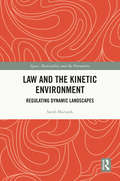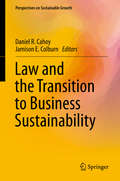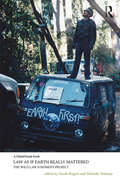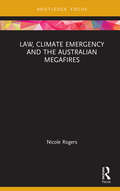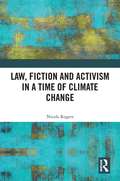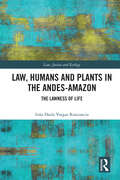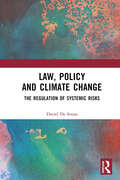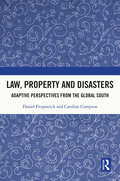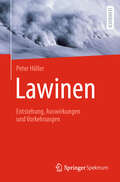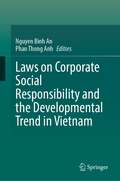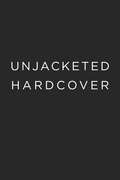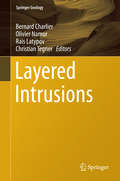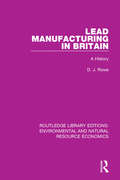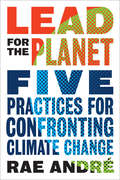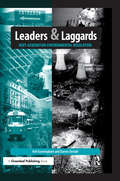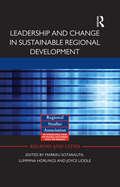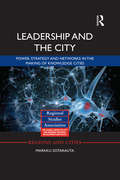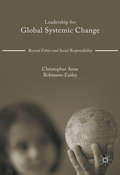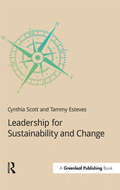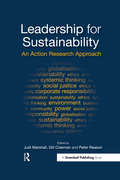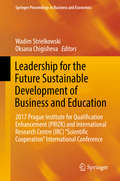- Table View
- List View
Law and the Kinetic Environment: Regulating Dynamic Landscapes (Space, Materiality And The Normative Ser.)
by Sarah MarusekThis book addresses the legal-geographical implications of the fact that landscapes are not static, but dynamic. Within the field of legal geography, the spatial relationship of law to landscape is usually considered to be static. Environments are often considered fixed, and consequently inert, as places that literally don’t go anywhere. Typically, then, it is what happens in these places, rather than the place itself, that commands academic attention. In contrast to this static viewpoint, Law and the Kinetic Environment considers how many landscapes are in flux and, as a result, may be seen as dynamic. Natural phenomena, such as oozing lava, moving glaciers, or bubbling geothermal pools, challenge and test the normative conceptualizations of stability of place, property ownership, and legal regulation. Consequently, such dynamic landscapes enliven and transform law, offering new jurisprudential insights into what law is and how it operates in response to the kineticism that, this book argues is, to some degree, inherent in all landscapes. This original engagement with legal geography will appeal to those with general interests in this area, as well as specific concerns with questions of law and place, property and the environment.
Law and the Transition to Business Sustainability
by Daniel R. Cahoy Jamison E. ColburnThis book expands on law-related research by examining the legal aspects of sustainability with a focus on the impact on business strategies. It recognizes that firms must adopt an integrated approach to law and sustainability, considering multiple disciplines and goals, and serve as a forum for bringing together scholarship from fields such as environmental law, energy, government regulation and intellectual property. Firms increasingly have an interest in transitioning to sustainable business practices that take into consideration the fact that global resources are finite and will be increasingly scarce. They acknowledge that current actions have social, economic and environmental consequences and employ options to ensure that future generations have the same options and benefits. Examples of sustainable practices increasingly employed by firms include the institutionalization of "whole life-cycle" analysis in marketing and product design, utilization of sustainable inputs and energy sources, tracking and reporting sustainability performance, attempting the valuation of future generation prosperity and happiness as a discounting mechanism, and integrating sustainability into firm culture and management goals. It is clear that law and regulation have an extremely important role to play in the transition to more sustainable business practices. Broadly stated, law can provide structure for firms responding to forces that pull transition by enabling sustainability leadership and competitive advantage through funding models, intellectual property rights and collaboration means. Additionally, law can work to push transition by compelling firms to act through regulatory structures, accounting and governance mechanisms.
Law as if Earth Really Mattered: The Wild Law Judgment Project (Law, Justice and Ecology)
by Nicole Rogers Michelle MaloneyThis book is a collection of judgments drawn from the innovative Wild Law Judgment Project. In participating in the Wild Law Judgment Project, which was inspired by various feminist judgment projects, contributors have creatively reinterpreted judicial decisions from an Earth-centred point of view by rewriting existing judgments, or creating fictional judgments, as wild law. Authors have confronted the specific challenges of aligning existing Western legal systems with Thomas Berry’s philosophy of Earth jurisprudence through judgment writing and rewriting. This book thus opens up judicial decision-making and the common law to critical scrutiny from a wild law or Earth-centred perspective. Based upon ecocentric rather than human-centred or anthropocentric principles, Earth jurisprudence poses a unique critical challenge to the dominant anthropocentric or human-centred focus and orientation of the common law. The authors interrogate the anthropocentric and property rights assumptions embedded in existing common law by placing Earth and the greater community of life at the centre of their rewritten and hypothetical judgments. Covering areas as diverse as tort law, intellectual property law, criminal law, environmental law, administrative law, international law, native title law and constitutional law, this unique collection provides a valuable tool for practitioners and students who are interested in learning more about the emerging ecological jurisprudence movement. It helps us to see more clearly what a new system of law might look like: one in which Earth really matters.
Law, Climate Emergency and the Australian Megafires
by Nicole RogersThis book addresses the ways in which the Black Summer megafires influenced the development of climate narratives throughout 2020. It analyses the global pandemic, and its ensuing restrictions, as a countervailing force in the production of such narratives. Lives and properties were lost in the spring and summer of 2019 and 2020, when catastrophic bushfires burnt through millions of hectares of mainland Australia. Nearly three billion native animals died. And for millions of Australians, and others worldwide, it was through the Australian megafires that the global climate emergency became tangible, concrete, no longer a comfortably deferred, albeit problematic abstraction which could be consigned to future generations to deal with. This book explores the legal and other implications of new understandings of climate emergency arising from the fires, and the emergence of a hierarchy of emergencies as the pandemic came to dominate global and domestic political discourses. It examines narratives of culpability, and legal avenues for seeking retribution from government and big fossil fuel emitters. It also considers the impact of the fires on the burgeoning phenomenon of climate activism, particularly in Australia, and the ways in which pandemic restrictions curtailed such activism. Finally, the book reflects on the fires through the lenses offered by climate fiction, and apocalyptic fiction more generally, in order to consider how these shape, and might shape, our responses to them. This important and timely book will appeal to environmental lawyers and socio-legal theorists; as well as other scholars and activists with interests in climate change and its impact. It is recommended for anyone concerned about current and future climate disasters, and the shortcomings in legal, political and popular responses to the climate crisis.
Law, Fiction and Activism in a Time of Climate Change
by Nicole RogersThe book examines the narratives of climate change which have developed and which are currently evolving in three areas: law, fiction and activism. Narratives of climate change generated by litigants, judges, writers of fiction and activists are having, and will have, a profound effect on the way we respond to the climate change crisis. Acknowledging the prevalence of unreliable narrators, this book explores the reliability and significance of different forms of climate narrative. The author analyses overlapping themes and points of intersection, considering the recurrent motif of the trickster, the prominence of the child, the significance and ongoing viability of the rights discourse, and the increasingly prevalent emergency framing with its multiple implications for law’s empire. She asks how law, fiction and activism measure up as textual and performative fora for telling the story of climate change and anticipating a climate-changed future. And, in addition, how can they help foster transformative narratives which empower us to confront the climate change crisis? This highly topical, cross-disciplinary work will be of interest to anyone concerned about the growing climate emergency and makes a valuable contribution to climate law, environmental law, the environmental humanities and ecocriticism.
Law, Humans and Plants in the Andes-Amazon: The Lawness of Life (Law, Justice and Ecology)
by Iván Darío Vargas RoncancioExtending law beyond the human, the book examines the conceptual openings, methodological challenges, and ethical conundrums of law in a time of socio-ecological transition. How do we learn and practice law across epistemic and ontological difference? What sort of methodologies do we need? In what sense does conjuring other-than-human beings as sentient, cognitive and social agents—rather than mere recipients of state-sanctioned rights—transform what we mean by law and rights of nature in Latin America and beyond? Legal institutions exclusively focused on human perspectives seem insufficiently capable of addressing current socio-ecological challenges in Latin America and beyond. In response, this book strives to integrate other-than-human beings within legal thinking, institutions, and decision-making protocols. Weaving together various fields of knowledge and worldmaking practices that include – but are not limited to – Indigenous legal traditions, ecological law, multispecies ethnography, and ecological economics, the book pursues a multi-sited ethnography that focuses on the entanglement of law, ecology, and Indigenous cosmologies in Southern Colombia. In so doing, it articulates a general post-anthropocentric legal theory which is proposed, a tool to address socio-ecological challenges such as climate change and bio-cultural loss. This book will be of interest to scholars and students in the disciplines of environmental law, Earth law and ecological law, legal theory and critical legal studies; as well as others working in the in the fields of Indigenous studies, environmental humanities, legal anthropology, and sustainability and climate change justice.
Law, Policy and Climate Change: The Regulation of Systemic Risks
by Dariel De SousaFocusing on systemic risks caused by climate change, this book examines how these risks can be effectively regulated to ensure resilience and avoid catastrophe. Systemic risks are risks that threaten the systems upon which society depends, including ecosystems, social systems, financial systems, and systems of infrastructure. Such risks are typically characterised by inherent complexity, profound uncertainty, and overwhelming ambiguity. In combination, these features pose significant regulatory challenges for policy and law-makers. Examining how different types of systemic risks caused by climate change are being regulated in four different jurisdictions – the EU, the UK, the US and Australia – this book identifies deficiencies associated with regulating systemic risks using a traditional approach, based on a linear relationship between risk and regulation, which is widely used to regulate risk. The book advances a regulatory approach that is, instead, founded on the concept of "risk governance". This involves a structured yet flexible, holistic, interdisciplinary and inclusive basis for responding to systemic risks; and it is, this book argues, a more effective basis for regulating systemic risks given their uncertainty, complexity and ambiguity. This book will appeal to academics, policy and law-makers and practitioners working at the intersection of law and policy in the areas of regulation, risk management and climate change.
Law, Property and Disasters: Adaptive Perspectives from the Global South
by Daniel Fitzpatrick Caroline ComptonThis book re-considers property law for a future of environmental disruption. As slogans such as “build the wall” or “stop the boats” affect public policy, there are counter-questions as to whether positivist or statist notions of property are fit for purpose in a time of human mobility and environmental disruption. State-centric property laws construct legal fictions of sovereign control over land, notwithstanding the persistent reality of informal settlements in many parts of the Global South. In a world affected by catastrophic disasters, this book develops a vision of adaptive governance for property in land based on a critical re-assessment of state-centric property law. This book will appeal to a broad readership with interests in legal theory, property law, adaptive governance, international development, refugee studies, postcolonial studies, and natural disasters.
Law, Tropical Forests and Carbon
by Rosemary Lyster Catherine MacKenzie Constance Mcdermott Rosemary Lyster Catherine MackenzieEmerging from the scientific parameters underpinning REDD+ (including the measurement of carbon stocks, reporting and verification), Law, Tropical Forests and Carbon considers the crucial challenges for global and national governance and the legal rights and interests of indigenous people and local communities, all of which have fundamental implications for development and poverty alleviation. With contributions from leading experts in the fields of law, governance, science, development studies and geography, it sheds light on the complexity of REDD+ and offers perspectives on the extent to which REDD+ agreements can be enforced under international law and in concert with new private and public domestic institutions.
Lawinen: Entstehung, Auswirkungen und Vorkehrungen
by Peter HöllerTauche ein in die umfassende Welt der Lawinenkunde, untermauert und veranschaulicht von eindrucksvollen Fotos und Abbildungen. Das vorliegende Buch spannt den Bogen von den für die Lawinenbildung maßgeblichen Bedingungen in der Schneedecke bis hin zu Präventionsmaßnahmen und Sicherheitsvorkehrungen. Es bietet unverzichtbare Informationen für alle Bergliebhaber und Skitourengeher, die ihre Touren sorgfältig planen möchten. Es spricht eine breite Zielgruppe an, darunter Profis wie Mitglieder von Lawinenkommissionen, Bergretter und Bergführer, ebenso wie Studierende der Geographie und Geowissenschaften. Auch Bergsportbegeisterte, seien es Alpinisten oder Wintersportler, finden hier wertvolle Informationen zur Beurteilung der Lawinengefahr, Gefahreneinschätzung im Gelände sowie Maßnahmen nach einer Lawinenverschüttung. Für Experten und Profis wird dieses Buch zu einem unverzichtbaren Nachschlagewerk, insbesondere mit den Kapiteln zu temporären Maßnahmen, lokaler Lawinenprognose unddem Verhalten im winterlichen Gelände. Studierende erhalten einen kompakten Überblick über das gesamte Fachgebiet, von den Prozessen in der Schneedecke über die Lawinenbildung bis zu den Schutzmaßnahmen. Ein umfangreiches, aktualisiertes Literaturverzeichnis nach jedem Abschnitt ermöglicht es, schnell relevante Arbeiten zu finden.
Laws of the Sea: Interdisciplinary Currents
by Irus BravermanLaws of the Sea assembles scholars from law, geography, anthropology, and environmental humanities to consider the possibilities of a critical ocean approach in legal studies. Unlike the United Nations’ monumental Convention on the Law of the Sea, which imagines one comprehensive constitutional framework for governing the ocean, Laws of the Sea approaches oceanic law in plural and dynamic ways. Critically engaging contemporary concerns about the fate of the ocean, the collection’s twelve chapters range from hydrothermal vents through the continental shelf and marine genetic resources to coastal communities in France, Sweden, Florida, and Indonesia. Documenting the longstanding binary of land and sea, the chapters pose a fundamental challenge to European law’s “terracentrism” and its pervasive influence on juridical modes of knowing and making the world. Together, the chapters ask: is contemporary Eurocentric law—and international law in particular—capable of moving away from its capitalist and colonial legacies, established through myriad oceanic abstractions and classifications, toward more amphibious legalities? Laws of the Sea will appeal to legal scholars, geographers, anthropologists, cultural and political theorists, as well as scholars in the environmental humanities, political ecology, ocean studies, and animal studies.
Laws on Corporate Social Responsibility and the Developmental Trend in Vietnam
by Nguyen Binh An Phan Thong AnhThis book examines the law and its development trends in the area of corporate social responsibility (CSR) in Vietnam. It is an important reference in implementing the requirements of CPTPP and EVFTA in Vietnam, and it is also very important in improving the legal framework in Vietnam to comply with international standards, especially in the areas of labor, environment and consumer protection, and in raising awareness of CSR among Vietnamese companies. Many articles in this book analyze and assess the legal status of CSR, thus providing a number of constructive suggestions for improving the relevant laws in Vietnam. Corporate social responsibility is not only the contribution of corporate philanthropy to society, but also the compliance of companies with international standards and national laws in the fields of labor, environment, investment, labor security, social security, etc. Against the backdrop of Vietnam's growing international integration, the requirement of corporate social responsibility has been, and continues to be, paramount in business activities. It is not only a need at the enterprise level, but is also related to the internationalization of international standards and the improvement of national laws on CSR.
Laws, Theories, and Patterns in Ecology
by Walter K. DoddsIntroductory material describes how the practice of science in general, and ecology specifically, yields theories and laws. Dodds also discusses why such ideas are only useful if they have predictive ability, and delineates the scope of these generalizations and the constraints that limit their application.
Layered Intrusions
by Bernard Charlier Olivier Namur Rais Latypov Christian TegnerThis edited work contains the most recent advances related to the study of layered intrusions and cumulate rocks formation. The first part of this book presents reviews and new views of processes producing the textural, mineralogical and geochemical characteristics of layered igneous rocks. The second part summarizes progress in the study of selected layered intrusions and their ore deposits from different parts of the world including Canada, Southwest China, Greenland and South Africa. Thirty experts have contributed to this update on recent research on Layered Intrusions. This highly informative book will provide insight for researchers with an interest in geology, igneous petrology, geochemistry and mineral resources.
Lead Manufacturing in Britain: A History (Routledge Library Editions: Environmental and Natural Resource Economics)
by D. J. RoweOriginally published in 1983. Extensive research into the archives of the lead industry has culminated in this comprehensive and fascinating account of the industry from the earliest times to the 1980’s. It traces the origins of the various types of lead manufacturing and the nineteenth-century expansion of the industry. The technological changes within the industry are traced in detail, and an appraisal of modern industry and its future prospects concluded this definitive and very readable history of the lead industry.
Lead for the Planet: Five Practices for Confronting Climate Change
by Rae AndreWith melting ice caps in the Arctic causing catastrophic environmental issues, it’s hard to believe that we’ve had to spend so much time convincing each other that climate change is real. Lead for the Planet shifts the focus to how we, the members of Team Humanity, are going to organize to solve the twin issues of climate change and energy evolution. The book channels a broad range of social science perspectives, from anthropology to psychology to economics, to help decision-makers explore how Team Humanity can get this thing done. Lead for the Planet outlines five practices that successful climate leaders will need to adopt, from getting the truth about the state of the planet, to assessing the risks and identifying the interests of key stakeholders, to implementing change within and between organizations and sectors on a global scale. Building on her experience as an organizational psychologist, Rae André shows how these practices comprise an effective model for climate leadership. Lead for the Planet is a guide for the kind of leadership that is necessary to help us all avoid the worst of global warming and to create a clean energy future for the generations to come.
Leaders and Laggards: Next-Generation Environmental Regulation
by Darren Sinclair Neil GunninghamConsensus is growing internationally that traditional command-and-control approaches to environmental regulation have borne much of their low-hanging fruit. Yet it is far from clear what should complement or replace them. Regulatory agencies and policy-makers are struggling with a lack of information about regulatory reform, about what works and what doesn't, and about how best to harness the resources of both government and non-government stakeholders. Progress is being impeded unnecessarily by a lack of shared knowledge of how similar agencies elsewhere are meeting similar challenges and by a lack of data on the success or otherwise of existing initiatives. Despite recent and valuable attempts to deal with such problems in the European Union and North America, these remain islands of wisdom in a sea of ignorance. For example, when it comes to dealing with small and medium-sized enterprises, very little is known, and what is known is not effectively distilled and disseminated. Much the same could be said about the roles of third parties, commercial and non-commercial, as surrogate regulators, and more broadly of many current initiatives to reconfigure the regulatory state. Based on the authors' work for the OECD, Victorian Environmental Protection Authority and the Western Australian Department of Environment Protection, Leaders and Laggards addresses these problems by identifying innovative regulatory best practice internationally in a number of specific contexts, evaluating empirically the effectiveness of regulatory reform and providing policy prescriptions that would better enable agencies to fulfil their regulatory missions. Focusing primarily on the differing requirements for both corporations and small and medium-sized enterprises in North America and Europe, the book aims to complement existing initiatives and to expand knowledge of regulatory reform by showing: how existing experience can best be put to practical use "on the ground"; by drawing lessons from experiments in innovative regulation internationally; by reporting and extrapolating on original case studies; and by advancing understanding on which instruments and strategies are likely to be of most value and why. The authors argue that the development of theory has outstripped its application. In essence, Leaders and Laggards aims to ground a myriad of theory on the reinvention of environmental regulation into practice. The book will be essential reading for environmental policy-makers, regulatory and other government officials responsible for policy design and implementation, academics and postgraduate students in environmental management, environmental law and environmental policy, and a more general readership within environmental policy and management studies. It will also be of interest to those in industry, such as environmental managers and corporate strategists, who are considering the use of more innovative environmental and regulatory strategies, and to environmental NGOs.
Leadership and Change in Sustainable Regional Development (Regions and Cities #60)
by Joyce Liddle Markku Sotarauta Lummina HorlingsThis book shows, first of all, that leadership plays a crucial role in reinventing regions and branching out from an old path to something new in order to create more balanced and sustainable regional development. Second, it maintains that leadership is not a solo but a multi-agent and -level activity and that it needs to be discussed and studied as such. Third, as the book argues, leadership is shaped differently in various institutional and cultural contexts and on different scales. This book explores the ways leadership plays our in regional development context contributing to economically, socially and ecologically balanced sustainable future.
Leadership and Organizational Sustainability: The Knowledge Management Approach (Routledge Studies in Management, Organizations and Society)
by Roberto Tuda Rivas Elia Socorro Díaz Nieto David Israel Contreras MedinaThe book presents a new type of leadership focused on sustainable human development and organizational sustainability, which is based on the self-realization of the person of the leader, which means the satisfaction of their needs, according to the scale of Abraham Maslow, through integral human development in all aspects of life. Because the term "leader" appears to refer to anyone with the authority to confer a position with subordinates, the reality within organizations has shown that a leader must go further and demonstrate commitment, awareness, and concern for the common good. Which person has these characteristics? People who have had more opportunity to develop in different areas of their being, resulting in them being conceived as more educated. The qualities in a person are the basis of leadership. Education and practice are much more important than all hereditary and genetic codes. This volume explores the various ways of making explicit the dimensions of social, economic, and environmental sustainability through knowledge management that addresses the identification, collection, processing, circulation, use, exchange, and preservation of knowledge within operating systems and the context of organizations, considering issues that contribute to sustainability – human and organizational – where the leader is the main actor and the means is knowledge management.
Leadership and the City: Power, strategy and networks in the making of knowledge cities (Regions and Cities)
by Markku SotarautaThe 21st century has been dominated by an almost compulsive race to find new pathways for city development. As cities seek to regenerate via the knowledge-based economy, now more than ever dynamic leadership is required order to navigate new and complex challenges while building community. This book is about generative leadership in knowledge city development. Leadership and the City is rooted in a conviction that the leadership in a city is crucial in order for it to adjust strategically to major transformations and thus secure a good future for its inhabitants. The book opens a fresh view of leadership by focusing on generative leaders and their modes of leading, instead of spatial categorisations, governance structures and/or policy contents and processes. It investigates generative leadership by elaborating the modes of leadership, power and strategies in influence networks. The key points are highlighted with several empirical cases. These include Akron and Rochester (USA), Münich (Germany), Leeds (UK), Barcelona (Spain) as well as Helsinki, Tampere and Seinäjoki (Finland). This book will be of interest to researchers and practitioners concerned with Leadership, Urban Studies and Strategic Management.
Leadership for Global Systemic Change: Beyond Ethics and Social Responsibility
by Christopher Anne Robinson-EasleyThis book argues that organizations, corporations, and governments have the abilities and resources to drive deep systemic change, yet fail to evoke change strategies that can significantly improve the social fabric of our global environment. It actively engages the reader in a conversation that reviews, evaluates, and challenges these issues juxtaposed to current strategies and resulting positions regarding business ethics, social responsibility, our view towards humanity, and the role of leaders.Provocative in its voice and message, this book demonstrates how more robust contributions can lead to effective change. The author includes a detailed change model designed to invoke significant global change that builds upon the current work of the United Nations’ Global Compact, and incorporates the participation of all critical stakeholders including corporate leaders, civil society, government leaders, and the people who are challenged daily by ethical dilemmas and social responsibility initiatives. It speaks to academics and students of change management, social responsibility, and business ethics, as well as the organizations and communities who stand to make a positive difference in the world.
Leadership for Sustainability and Change (Doshorts Ser.)
by Cynthia Scott Tammy EstevesWe live in challenging times. New leaders are enhancing their "inner game" to maximize their organizational impact, and using the principles of sustainability to help their organizations thrive and innovate in response to 21st century challenges. Leadership for Sustainability and Change is a concise, practical and energizing distillation of what is working for today's most successful sustainability leaders. It provides a clear set of actions you can take to generate transformation, with results yielding market advantage, eco-efficiency, product or service innovation, personal resilience and engaged communities. Learn from the experience of successful sustainability leaders how to: build personal resilience and agility to lead change for the long-run; sustain innovation that is released in bursts of focused "energy for good"; draw attention to what is working by focusing on the power of small differences; decrease resistance and increase motivation with a change acceleration model; identify stages of individual and organizational readiness for change; use rapid prototyping to increase group engagement; tell compelling stories to encourage teams to initiate action. Leadership for Sustainability and Change offers guidance for leaders who are shaping the future of sustainability within their organizations. The book includes a simple framework for assessing your progress, so that you can revisit the tools and processes you need most.
Leadership for Sustainability: An Action Research Approach
by Peter Reason Judi Marshall Gill ColemanThose who advocate moving towards sustainability debate how change can be achieved. This book focuses on what it means to take up leadership for sustainability, from a variety of organizational and social positions, and considers the consequences of different strategies and practices for influencing change.
Leadership for Sustainability: Strategies for Tackling Wicked Problems
by R. Bruce Hull David P. Robertson Michael MortimerSolving today's environmental and sustainability challenges requires more than expertise and technology. Effective solutions will require that we engage with other people, wrestle with difficult questions, and learn how to adapt and make confident decisions despite uncertainty. We need new approaches to leadership that empower professionals at all levels to tackle wicked problems and work towards sustainability. Leadership for Sustainability gives readers perspective and skills for promoting creative and collaborative solutions. Blending systems thinking approaches with leadership techniques, it offers dozens of strategies and specific practices, illustrated by inspiring case studies. Readers will come away with a holistic understanding of how to lead from where they are by applying leadership principles and practices to a wide range of wicked situations.
Leadership for the Future Sustainable Development of Business and Education: 2017 Prague Institute For Qualification Enhancement (prizk) And International Research Centre (irc) Scientific Cooperation International Conference (Springer Proceedings In Business And Economics)
by Wadim Strielkowski Oksana ChigishevaThis proceedings volume examines leadership from the perspectives of business, economics, social sciences, cross-cultural management, and education as a means to establish a future of sustainable development. Featuring contributions from the 2017 Prague Institute for Qualification Enhancement (PRIZK) and International Research Centre (IRC) “Scientific Cooperation” International Conference held in the Czech Republic, this volume focuses particularly on business models and higher education schemes from BRICS nations and examines topics such as social and educational practices, academic policies and business development. Leadership is becoming a key element for the future sustainable development of business and education in the quickly globalizing world. In this regard, a special emphasis should be made on the formation of high-quality human resources—the leading experts in their field who will create innovations and introduce breakthrough technologies. The development of a creative economy and knowledge economy requires highly-educated human capital, thus education becomes a key element of this process. Education must keep pace with time, be competitive, and stay in touch with the process of technology. The enclosed papers identify the key steps for sustainable growth and development in business and education. Featuring contributions on theory and practice, this book is appropriate for academics, researchers, policy-makers and practitioners in the areas of business, leadership management, entrepreneurship, innovation and education.
